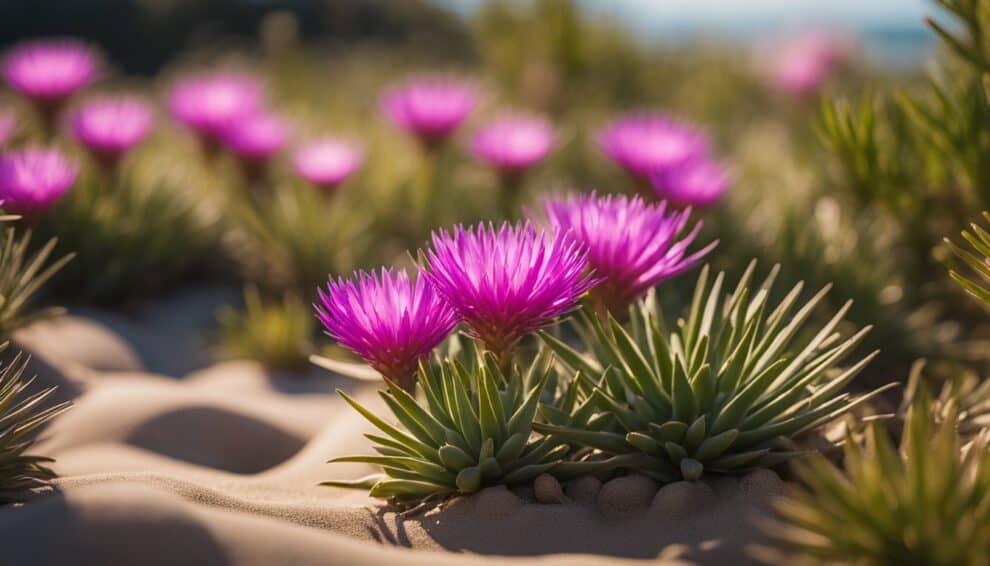The Carpobrotus Edulis, commonly known as the ice plant, is a succulent plant that is native to South Africa.
It is a popular plant for landscaping and is often used to control soil erosion due to its ability to spread quickly and cover large areas.
However, many people are not aware of the plant’s unique properties and potential benefits.

This article aims to provide beginners with useful information about the Carpobrotus Edulis, including its origins, characteristics, and uses.
It will cover the plant’s physical appearance, growth habits, and environmental requirements.
Additionally, it will explore its medicinal properties and culinary uses, providing readers with a comprehensive understanding of this fascinating plant.
Understanding Carpobrotus Edulis
Botanical Profile
Carpobrotus Edulis, commonly known as the ice plant, is a succulent plant species that belongs to the Aizoaceae family.
It is native to South Africa and is widely distributed in coastal regions around the world.
The ice plant has thick, fleshy leaves that are green in color and can grow up to 10 centimeters long.
The leaves are also covered with small, white, and sometimes pinkish hairs that give the plant a frosty appearance.
The ice plant produces large, showy flowers that are pink or purple in color and bloom in the summer.
Common Names and Synonyms
The ice plant is known by several common names, including Hottentot fig, sour fig, and sea fig.
It is also referred to as Mesembryanthemum edule, which is a synonym for Carpobrotus Edulis.
The ice plant is called Hottentot fig because it was first discovered by European explorers in the Hottentots Holland Mountains of South Africa.
The name “sour fig” refers to the plant’s edible fruit, which has a sour taste and is used in jams and jellies.
In conclusion, understanding the botanical profile and common names of Carpobrotus Edulis is essential for beginners who want to learn more about this fascinating plant.
Cultivation Essentials

Planting Guidelines
Carpobrotus edulis is a succulent plant that is easy to grow and maintain. It can be propagated by seeds or cuttings.
For best results, plant the ice plant in well-draining soil with a pH range of 6.0 to 7.5. The plant prefers full sun but can tolerate partial shade.
When planting, ensure that the root ball is level with the soil surface.
Water the plant thoroughly after planting and then allow the soil to dry out before watering again. Avoid overwatering as this can lead to root rot.
Growth Conditions
Carpobrotus edulis thrives in warm climates and can tolerate drought conditions.
The plant can grow up to 1 foot tall and 4 feet wide, with fleshy green leaves and pink or purple flowers that bloom in the summer.
The ice plant is a hardy plant that can tolerate salt spray and wind, making it an ideal plant for coastal gardens.
It is also resistant to pests and diseases.
Maintenance and Care
To maintain the health and appearance of the ice plant, it is important to prune it regularly.
Pruning helps to promote bushier growth and prevent the plant from becoming too leggy.
Fertilize the plant with a balanced fertilizer during the growing season to encourage healthy growth.
Water the plant sparingly during the winter months when it is dormant.
Overall, Carpobrotus edulis is a low-maintenance plant that is perfect for beginners.
With proper planting, growth conditions, and maintenance, the ice plant can thrive and add beauty to any garden.
Environmental Impact and Uses

Ecological Considerations
Carpobrotus edulis, commonly known as the ice plant, is a succulent plant native to South Africa.
It was introduced to other parts of the world as an ornamental plant and for soil stabilization.
However, it has become an invasive species in many areas, including coastal regions of California, Australia, and New Zealand.
The ice plant is known to outcompete native plant species and alter the soil chemistry, leading to changes in the ecosystem.
It is also able to survive in harsh conditions and can spread rapidly, making it difficult to control.
As a result, many conservation organizations are working to remove the ice plant from affected areas and restore native habitats.
It is important to be aware of the potential ecological impact of introducing non-native species and to take steps to prevent their spread.
Practical Applications
Despite its negative impact on the environment, the ice plant has some practical applications.
It is commonly used in landscaping due to its attractive appearance and ability to withstand drought and salt spray.
In addition, the plant has medicinal properties and has been used in traditional medicine to treat a variety of ailments, including burns and infections.
Its high vitamin C content also makes it a popular ingredient in some food products.
Overall, while the ice plant may have some practical uses, it is important to be aware of its potential negative impact on the environment and take steps to prevent its spread.
Frequently Asked Questions

What are the medicinal benefits of Carpobrotus edulis?
Carpobrotus edulis has been used for medicinal purposes for centuries.
The plant’s leaves, stem, and roots contain a variety of compounds that have been found to have anti-inflammatory, antimicrobial, and antioxidant properties.
Some traditional remedies include using Carpobrotus edulis to treat wounds, burns, and skin irritations.
However, it is important to note that more research is needed to fully understand the plant’s medicinal benefits.
Can the fruit of Carpobrotus edulis be eaten, and what does it taste like?
Yes, the fruit of Carpobrotus edulis is edible and has a sweet and slightly tart taste.
The fruit can be eaten fresh or used to make jams, jellies, and syrups.
However, it is important to note that the fruit should be consumed in moderation as it has a laxative effect.
What is the common name for Carpobrotus edulis?
Carpobrotus edulis is commonly known as the Ice Plant or Hottentot Fig.
How is the Hottentot fig used in traditional remedies?
The Hottentot fig has been used in traditional remedies to treat a variety of ailments including coughs, colds, and stomach problems.
The plant’s leaves and juice have also been used to soothe burns and skin irritations.
Is the Ice Plant considered an invasive species in certain regions?
Yes, the Ice Plant is considered an invasive species in many regions where it has been introduced.
The plant is able to outcompete native vegetation and disrupt ecosystems. In some areas, efforts are being made to control or eradicate the plant.
What environmental impacts does the Ice Plant have in non-native ecosystems?
The Ice Plant can have a number of negative environmental impacts in non-native ecosystems.
The plant can alter soil chemistry, reduce water availability, and create dense monocultures that displace native vegetation.
This can have a cascading effect on other species that rely on the ecosystem, potentially leading to declines in biodiversity.














